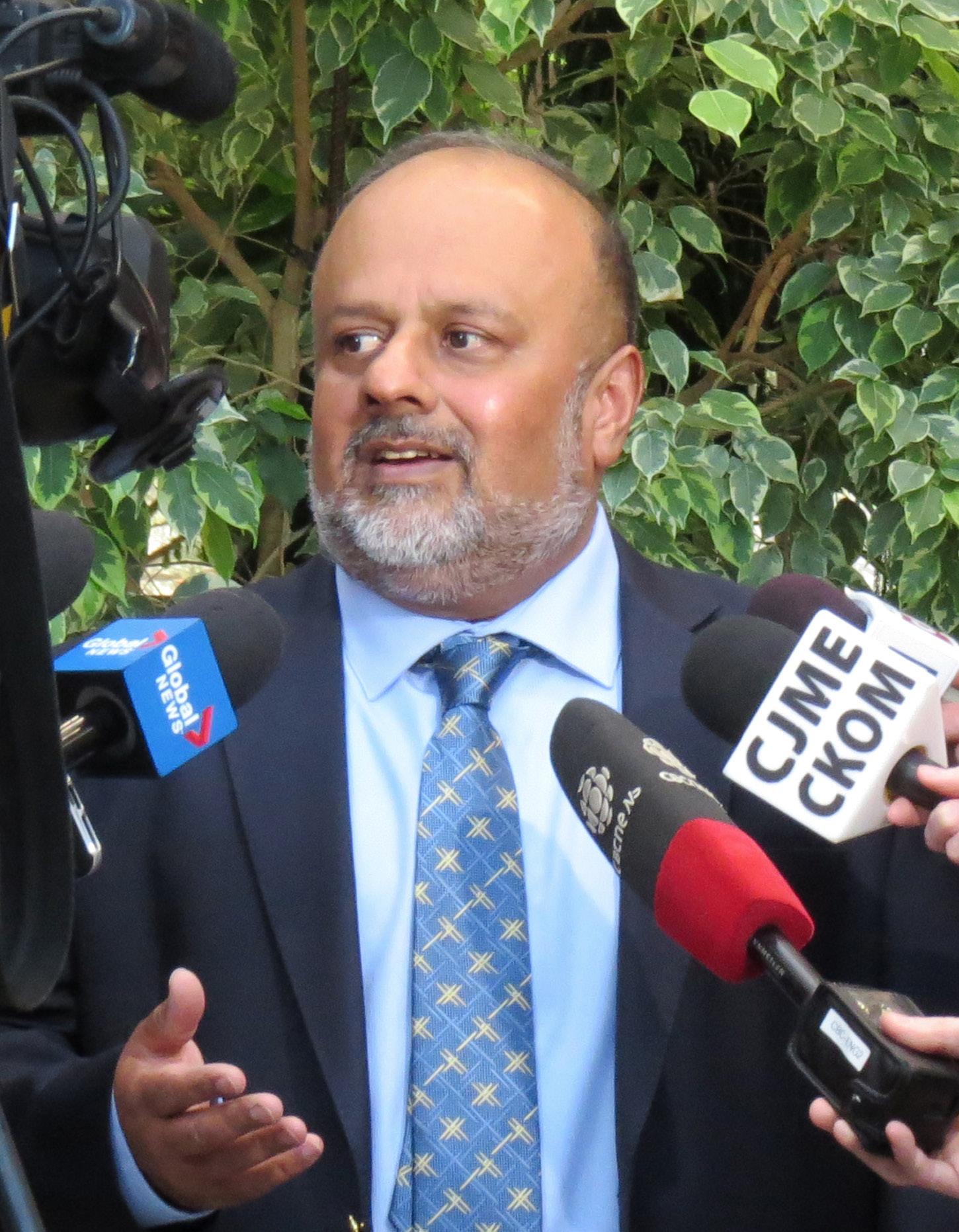
7 minute read
The face of Saskatchewan’s COVID-19 response
By Girard Hengen
He could quite possibly be the most high-profile physician in Saskatchewan at the best of times, let alone during a worldwide pandemic that has shut down the province – and indeed the world – on an unprecedented scale.
Dr. Saqib Shahab, the Chief Medical Health Officer for Saskatchewan’s Ministry of Health, is the face of the public health response to crisis situations, including the spread this year of the COVID-19 coronavirus.
“Knowledge is power and I think the right information at the right time is essential,” Dr. Shahab told the SMA.
“When we have a pandemic, for example, it’s important to give clear information about what is our best estimate about what is going to happen and as things change, whether we think it’s going to get better or worse, keep updating the public regularly,” he said. “If people are well-informed and understand how it’s going to play out and what steps they need to take at an individual level, at a family level, at a community level, I think that really helps.”
Dr. Shahab holds regular briefings with the media, and through them speaks to the public, on health issues that affect the population, from measles scares, and the advance of the West Nile virus, to pandemics such as SARS in 2003 and the H1N1 virus in 2009.
The public has been watching and listening to his every word like never before during the COVID-19 pandemic. Sometimes he is praised, sometimes he receives criticism. Public reaction has ranged widely: the province’s initial response was too fast, the province moved too slowly at first, the re-opening is too risky, the re-opening is too cautious.
“One always has to have an open mind and to listen humbly and closely to all points of view,” Dr. Shahab said of his public role. “And one has to always course correct based on what new evidence is showing, and what is feasible and possible within a specific context.”
Dr. Shahab practised as an internist in the United Kingdom and Pakistan, but after several years the public health field beckoned. Born in Britain, he received his education there and in Pakistan. He did his medical degree in Pakistan and moved back to Britain for internal medicine training.
While in Pakistan in the early 1990s, Dr. Shahab became aware of preventative medicine and how it improves the health of a population. A couple of moments were transformative. One day in his clinic, he saw three patients in a row with typhoid fever. After work he went with them to their village, where the water well appeared clean and up to standards. However, nearby was a septic tank that was contaminating the well. Whoever built the tank did not consult public health bylaws. This lack of awareness and application of basic public health guidelines had contaminated the water supply of the entire village.
Another “watershed” moment was the release of the Whitehall study of British public servants, which showed a steep inverse relationship between social class – as measured by occupation – and mortality from a range of diseases. The higher the job classification, the better the outcomes. The World development report 1993: Investing in health, which examined the linkages between human health, health policy and economic development, also had an impact on Dr. Shahab. Slowly, over a period of years, he thought about changing his field to public health.
Dr. Shahab completed a master’s in public health from Johns Hopkins University in the U.S. He equates the difference between internal medicine and public health as using a telephoto lens on a camera to view a single task up close (internal medicine), to switching to a wide-angle lens and seeing the big picture (public health).
“My viewpoint shifted from a patient or a clinical disease to the population level,” he said. The Whitehall study showed that the more control a person had on his or her life, and the better the income, the better the health. The health system itself could not deal with reducing disparities in health outcomes, Dr. Shahab noted.
“Those things really spurred my interest for prevention and outcomes,” he said. “It was a mid-career decision, but currently one that has been really satisfying for me both professionally and personally.”
Dr. Shahab and his family moved to Saskatchewan prior to his completion of a second reentry residency – this time in public health – at the University of Alberta. He found Saskatchewan and Canada fascinating from a public health perspective.
Geographically huge and sparsely populated, the region contrasted with what he had known in Britain and Pakistan. The public health community here is small and tightly knit. Public health physicians in Saskatchewan have an opportunity to work with family physicians as well as specialists across disciplines. He also works with local leaders, school and municipal officials, and First Nations to improve health outcomes for communities.
“There’s a very collaborative approach, a really practical and pragmatic approach to things that I enjoy,” he said. “We talk about social determinants of health, how do social determinants like income, education and other factors such as how what happens at home and in the community affects health – we collaborate and talk about that.
“That state of collaboration and looking outside the box is the true strength of health care in Canada.”
Dr. Shahab worked as a regional medical health officer in Yorkton before moving to Regina in 2009 for the position of deputy chief medical health officer with the Ministry of Health. He became provincial chief medical health officer in 2012. Dr. Shahab is a past chair of the Medical Health Officers Council of Saskatchewan and past-president of the Saskatchewan Public Health Association. He is currently cochair of the Pan Canadian Public Health Network Council, which has met to coordinate responses to the COVID-19 coronavirus.
He has become a familiar figure since coming to Regina in 2009, speaking to reporters in print, radio and television. It’s simply part of the job.
“It’s a privilege to be able to speak directly to the population of Saskatchewan,” Dr. Shahab said. “The media plays a very valuable role in conveying factual information and it’s been a really positive experience working with the media, working with our communications teams, working with the ministry and the SHA, to get the right information out. It’s an important part of our work.”
From a public health perspective, the COVID-19 outbreak presented physicians with a “rapidly changing environment,” one that initially appeared localized to China’s interior and a few countries in the world in January 2020, but one that had spread across the world by March.
Dr. Shahab said the provincial health system – the Health Ministry, Saskatchewan Health Authority (SHA), public health, primary care physicians, acute care facilities and staff – had to be prepared at the outset, given the rapid spread elsewhere of COVID-19.
“We have to create a system that if we were to see limited community transmission in Saskatchewan, how could we try to manage that in a way that we minimize either further transmission in the community, or through public health measures and other measures we slow down the transmission?
“That’s what pandemic preparedness and response is all about. You initially try to contain, so that the virus will not come into Canada or if it comes, to keep it very limited. But once it becomes established as a global pandemic, we needed to be prepared. What public health measures do we take to reduce the spike of the curve?”
The number of cases in Saskatchewan has remained relatively low compared to other jurisdictions, although outbreaks have been affecting communities in the north and communal living settings throughout the province.
“So far Saskatchewan has done well, but this is a marathon and not a sprint,” Dr. Shahab said. “At present, it is not back to business as usual but adjusting to a new normal for the next little while.”
Dr. Shahab attributes any success the province has had in “flattening the curve” of the pandemic to a “team effort” involving the entire health system, and the people of Saskatchewan, who have by and large followed public health directives. But someone has to be prepared to face the TV cameras and calm a restless, possibly anxious and afraid, public. Someone has to be labelled by the media – fairly or not – the province’s “top doc.” In Saskatchewan, that job falls to Dr. Saqib Shahab. His philosophy is simple – facts matter.
“I think there are some areas, such as public health decisions, that do fall to medical health officers at a local level and the chief medical health officer at a provincial and government level,” he said. “But these decisions are always based on principles of public health practice.
“People are highly educated. They’re really involved in their health. I think giving the right factual information is essential, and then explain how your community is at risk for whatever the risk is that people are concerned about, and what can all of us do collectively and individually to minimize that risk.”◆










